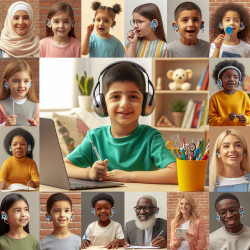As a practitioner dedicated to enhancing the communication skills of children with cochlear implants (CI), understanding the latest research is crucial. The study titled Receptive Vocabulary of Children With Bilateral Cochlear Implants From 3 to 16 Years of Age offers valuable insights into the receptive vocabulary development of children with CIs and highlights factors that can influence their language outcomes. This blog aims to summarize the key findings and suggest practical applications for improving therapy outcomes.
Key Findings
The study compared the receptive vocabulary of children with bilateral CIs to that of their peers with typical hearing (TH) and found significant differences. On average, children with CIs had poorer receptive vocabulary than their TH peers, with the largest gap observed around 8.7 years of age. However, when comparing based on hearing age (time since implantation), the differences were less pronounced.
Age-Related Differences
The study identified a U-shaped effect of age on the receptive vocabulary scores of children with CIs:
- The gap between CI users and TH peers was smallest at the beginning (3 years) and end (16 years) of the age range.
- The largest gap occurred around 8.7 years of age.
Predictors of Vocabulary Outcomes
Several child-level characteristics were found to be significant predictors of receptive vocabulary outcomes:
- Type of implantation (simultaneous vs. sequential)
- Communication mode at school
- Social integration (frequency of avoiding social situations due to hearing loss)
Practical Applications
Based on these findings, practitioners can adopt several strategies to improve language outcomes for children with CIs:
Continuous Monitoring and Support
Given the U-shaped effect of age, continuous monitoring and support are crucial, especially around school entry (approximately 6-9 years). Regular assessments can help identify children who are falling behind and require additional intervention.
Tailored Interventions
Interventions should be tailored to the individual needs of the child, considering factors such as the type of implantation and communication mode used at school. For example:
- Children with sequential implants may benefit from targeted vocabulary enrichment activities.
- Those using sign language support might need integrated approaches that combine sign and spoken language.
Enhancing Social Integration
Encouraging social integration is essential. Children who avoid social situations due to hearing loss tend to have poorer vocabulary outcomes. Strategies to improve social integration include:
- Facilitating peer interactions in inclusive settings.
- Providing social skills training and support groups.
Encouraging Further Research
While this study provides valuable insights, further research is needed to explore the long-term impacts of early interventions and the role of other potential predictors such as cognitive abilities and family support. Practitioners are encouraged to stay updated with the latest research and consider participating in studies that contribute to the body of knowledge in this field.
To read the original research paper, please follow this link: Receptive Vocabulary of Children With Bilateral Cochlear Implants From 3 to 16 Years of Age.










